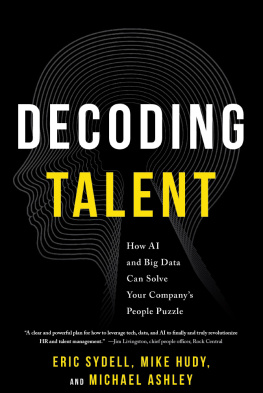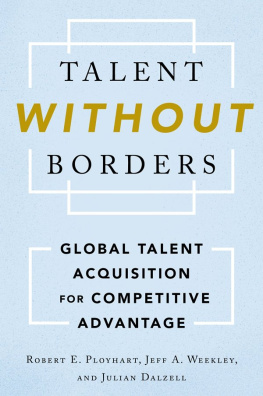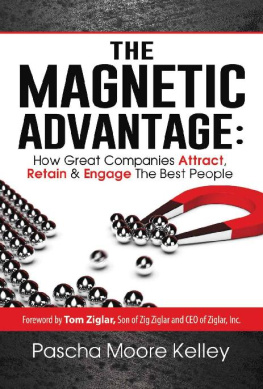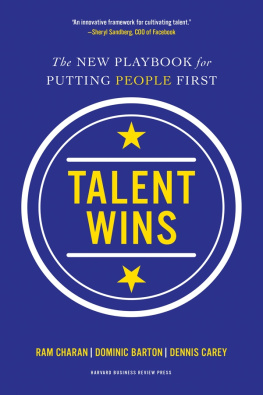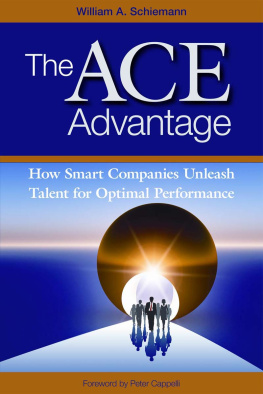
Copyright 2014 by CareerBuilder, Lorin Hitt, and Prasanna Tambe. All rights reserved. Except as permitted under the United States Copyright Act of 1976, no part of this publication may be reproduced or distributed in any form or by any means, or stored in a database or retrieval system, without the prior written permission of the publisher.
ISBN: 978-0-07-182713-3
MHID: 0-07-182713-7
The material in this eBook also appears in the print version of this title: ISBN: 978-0-07-182712-6, MHID: 0-07-182712-9.
E-book conversion by codeMantra
Version 1.0
All trademarks are trademarks of their respective owners. Rather than put a trademark symbol after every occurrence of a trademarked name, we use names in an editorial fashion only, and to the benefit of the trademark owner, with no intention of infringement of the trademark. Where such designations appear in this book, they have been printed with initial caps.
McGraw-Hill Education eBooks are available at special quantity discounts to use as premiums and sales promotions, or for use in corporate training programs. To contact a representative please visit the Contact Us page at www.mhprofessional.com.
TERMS OF USE
This is a copyrighted work and McGraw-Hill Education and its licensors reserve all rights in and to the work. Use of this work is subject to these terms. Except as permitted under the Copyright Act of 1976 and the right to store and retrieve one copy of the work, you may not decompile, disassemble, reverse engineer, reproduce, modify, create derivative works based upon, transmit, distribute, disseminate, sell, publish or sublicense the work or any part of it without McGraw-Hill Educations prior consent. You may use the work for your own noncommercial and personal use; any other use of the work is strictly prohibited. Your right to use the work may be terminated if you fail to comply with these terms.
THE WORK IS PROVIDED AS IS. McGRAW-HILL EDUCATION AND ITS LICENSORS MAKE NO GUARANTEES OR WARRANTIES AS TO THE ACCURACY, ADEQUACY OR COMPLETENESS OF OR RESULTS TO BE OBTAINED FROM USING THE WORK, INCLUDING ANY INFORMATION THAT CAN BE ACCESSED THROUGH THE WORK VIA HYPERLINK OR OTHERWISE, AND EXPRESSLY DISCLAIM ANY WARRANTY, EXPRESS OR IMPLIED, INCLUDING BUT NOT LIMITED TO IMPLIED WARRANTIES OF MERCHANTABILITY OR FITNESS FOR A PARTICULAR PURPOSE. McGraw-Hill Education and its licensors do not warrant or guarantee that the functions contained in the work will meet your requirements or that its operation will be uninterrupted or error free. Neither McGraw-Hill Education nor its licensors shall be liable to you or anyone else for any inaccuracy, error or omission, regardless of cause, in the work or for any damages resulting therefrom. McGraw-Hill Education has no responsibility for the content of any information accessed through the work. Under no circumstances shall McGraw-Hill Education and/or its licensors be liable for any indirect, incidental, special, punitive, consequential or similar damages that result from the use of or inability to use the work, even if any of them has been advised of the possibility of such damages. This limitation of liability shall apply to any claim or cause whatsoever whether such claim or cause arises in contract, tort or otherwise.
Contents
Acknowledgments
Numerous individuals were indispensable in the production of this book. We especially thank the CareerBuilder executives and product managers whose work underlies much of the data and content seen throughout the text, including: Brent Rasmussen, president of Career-Builder North America; Rosemary Haefner, vice president of human resources; Hope Gurion, chief development officer; Jennifer Seith, managing director of Talent Network; Abdel Tefridji, vice president of workforce analytics; Sanja Licina, senior director of workforce analytics; and Eric Presley, chief technology officer, and Roger Fugett, senior vice president of IT, who along with Dan Cosey and Rob Wittes, were instrumental in implementing CareerBuilders Re-employment Initiative.
We owe our gratitude to the many talented sales executives and representatives whose work with clients made the interviews for this book possible, including: John Smith, president, Enterprise Sales; Jason Lovelace, president, CareerBuilder Healthcare; Eric Gilpin, president, Staffing and Recruiting Group; as well as, Brian Donahue, William Emmons, Andrew Streiter, Beth Prunier, Jon Ralph, Steve Million, Laura Lynn, Jason Stewart, Brian Johnson, and Matt Laurinas.
We appreciate the support given by the professionals and economists at Economic Modeling Specialists International (EMSI)CEO Andrew Crapuchettes, Hank Robison, Tim Nadreau, Josh Wright, and Rob Sentz. Additionally, we are grateful for the insightful comments offered by Puneet Manchanda, chair of marketing and professor of marketing at the Ross School of Business at the University of Michigan.
Special thanks are in order to Anthony Balderrama, Debra Auerbach, Susan Ricker, Matt Tarpey, and Amy McDonnell for reviewing the text and lending a wonderful editing eye. For her work organizing the books many tables and figures, we also thank Susan Moye. We are also grateful for the ideas and support offered by other members of CareerBuilders marketing team: Jamie Womack, Stephanie Gaspary, Leah Mckelvey, Mike Erwin, Keith Hadley, Mary Lorenz, Justin Thompson, and Jenny Weigle. Finally, we thank CareerBuilders Ellen Silva, Jonathan Seaver, and Brianna Greene for their help acquiring key information for this project.
Introduction: Big Data and HR
Big data is a big differentiator. Every day, according to IBM, the world creates 2.5 quintillion bytes of data. For the record, quintillion has 18 zeros. IBM contends that 90 percent of the data published today has been created in the last two years alone. Much of that data can be used to make smarter, faster and higher-yielding business decisions.
Large companies are undoubtedly familiar with the applications of big data, but until recently the focus has been primarily on the consumer end. Every click of our mouse and swipe of our credit card leaves behind a trail of data, and companies are racing to collect it, store it, and learn from it. As a result, segmenting consumer behavior first through sales receipts and later through web analytics has revolutionized sales and marketing. It continues to evolve today. The predictive behavior models that the best consumer goods companies use are essentially able to determine what their customers want before they even know they want it. The ability to process and learn from these datasets is as important as the product or service itself to overall market performance.
Seeing this obvious success, executives around the country are now asking: What can big data do for human resources? Think about the massive amount of information a company keeps on their employeeswork histories, demographic profiles, education levels, skills competencies, compensation and benefit figures, performance and productivity measurestheres practically no end to the information residing within the typical HR department. As is the case with most data stored on servers or in file cabinets, however, human capital data is widely untouched, due to an inability or lack of initiative to steamline, process, store, and, most importantly, analyze it.
The Talent Equation is about using an incredible quantity of human capital data to create achievable solutions for leaders in the C-suite and HR. Emphasis on this topic was in part refueled by the success of the 2011 film (and 2003 Michael Lewis book of the same name)
Next page

